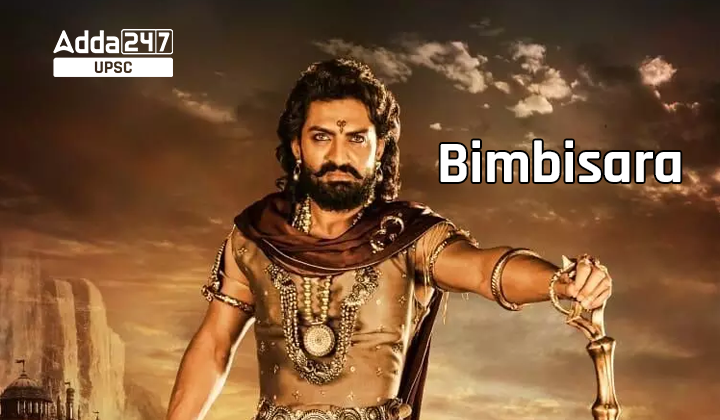Table of Contents
Introduction: Bimbisara, a key figure in ancient Indian history, played a pivotal role in expanding the Magadha Empire through strategic military campaigns and diplomatic alliances. Known for his efficient administrative reforms, Bimbisara established a well-organized governance system that included meticulous tax collection and the appointment of high-ranking officials. His open-minded approach to religious tolerance and encouragement of arts and crafts left a lasting positive impact on the cultural landscape of Magadha.
Bimbisara Biography For UPSC Aspirants
- Bimbisara, born around 558/559 BC, was the son of chieftain Bhattiya.
- Ascended to the throne of Magadha at age 15 in 543 BCE.
- The first campaign targeted Brahmadatta, ruler of the Anga kingdom, with objectives of revenge and exploiting the commercial potential.
- Bimbisara, trained in warfare, proved to be a skilled general.
- Successfully conquered the Anga kingdom and appointed his son Ajatashatru as its governor.
- Access to oceanic routes of the Anga kingdom facilitated flourishing overseas trade in the Magadha Empire.
- Ajatashatru was placed in command to understand the administrative setup and commercial activities.
- Bimbisara established the Haryana dynasty and expanded the Magadha empire.
- Fortified the village of Pataliputra, which later became the capital of Magadha after Rajagriha.
- Bimbisara’s court included notable figures like Sona Kolivisa, Sumana (flower gatherer), Koliya (minister), Kumbhaghosaka (treasurer), and Jivaka (physician).
Initial Victories and Matrimonial Alliances
- Following the conquest of the Anga kingdom, Bimbisara redirected his attention to other prominent regions in the subcontinent.
- Considering the constraints of his military size and capability, he pursued marriage alliances with kingdoms beyond his forceful reach.
- Despite being a skilled warrior, Bimbisara recognized the strategic value of forming alliances with powerful kingdoms to enhance his domain.
- Bimbisara initiated an alliance with the Kosala kingdom by marrying King Prasenjit’s sister and acquiring the holy city of Kashi as part of the dowry.
- Kashi, being a lucrative source of income, contributed to fortifying the foundations of Magadha and resolving the rivalry between Kosala and Magadha.
- Additionally, Bimbisara formed an alliance with the formidable Vrijji confederation. He married Chellana, a Licchavi Princess from Vaishali, and Kshema, belonging to the Madri clan of Middle Punjab.
- Having solidified his position through strategic alliances, Bimbisara turned his attention to Avanti, a powerful kingdom with its capital in Ujjain.
- However, neither Pradyota, the ruler of Avanti nor Bimbisara emerged victorious in their conquests, prompting Bimbisara to shift his strategy.
Opting for a diplomatic approach, Bimbisara established friendly relations with Avanti, marking a shift in his pursuit of power in the region.
Buddhism
- Bimbisara, a contemporary of Buddha, remained a devoted supporter of Buddha throughout his life. It was under Buddha’s guidance that Bimbisara first encountered the principles of emancipation, including teachings on generosity, morality, heavenly rewards, the pitfalls of sensual pleasures, and the four noble truths of Buddhism.
- The deep connection between Bimbisara and Buddhism is evident in various incidents linked to the philosophy. Bimbisara not only expressed affection and support for Buddha but also displayed compassion towards Buddhist monks, governing in accordance with the Dhamma imparted by Buddha.
- Buddha welcomed Bimbisara’s suggestions, one of which was incorporated into the ‘Vinaya Rule,’ specifying that individuals in royal service who had committed theft or broken jail should not be considered monks. Bimbisara also proposed the recital of the rules of discipline, or ‘Patimokha,’ on the eighth and last days of the month. Additionally, he recommended the practice of monks retreating during the rainy season from the second full moon.
- Encouraging his household members to visit Buddha, Bimbisara’s wife, Khema, became a devoted supporter of Buddha and joined the Sangha. Despite this close relationship, there is no record of Buddha delivering special teachings or answering specific questions posed by Bimbisara.
- Bimbisara generously hosted Buddha and his disciples in his pleasure park, known as ‘Veluvana,’ allowing them to stay as they pleased. Furthermore, the first Buddhist council following Buddha’s demise took place in Bimbisara’s capital, Rajagriha.
Jainism
- According to Jain literature, Bimbisara, known as the Shrenika of Rajgir, embraced Jainism after being impressed by the serenity of Jain monks from the Digambara and Svetambara sects. He regularly visited Mahavira’s preaching hall to seek answers to his inquiries.
- The Jain texts narrate that Bimbisara met a tragic end, taking his own life in a fit of passion after being imprisoned by his son, Ajathasathru. It is mentioned that he was subsequently reborn in hell and currently resides there. Recognized for his close association with Vartamana Mahavira, he is acknowledged as the first of the twenty-four Tirthankaras. The literature also predicts his future rebirth as Mahapadma, the inaugural Tirthankara in the next cycle of life.
Administration
- Bimbisara initiated significant reforms to streamline the administrative structure of the Magadha Empire, a model subsequently followed by later dynasties. Despite a relatively limited number of military expeditions, he undertook numerous campaigns that expanded the Empire.
- The kingdom of Magadha, encompassing approximately 70,000 villages, saw the appointment of a headman for each village tasked with overseeing administration and tax collection. Bimbisara, to ensure effective tax collection, established a hierarchy of officers to supervise the process.
- Bimbisara’s administrative prowess manifested in the meticulous organization of the Empire. High-ranking officials were strategically placed in judicial, political, and financial roles, with a stringent system for assessing and replacing inefficient officers. Bimbisara also considered the counsel of esteemed ministers in his decision-making.
- In his conquests, Bimbisara defeated Brahmadatta of Anga, annexing the kingdom, while maintaining amicable relations with Avanti. Four military divisions, comprising cavalry, infantry, chariots, and elephants, were meticulously maintained, and a navy was established post the conquest of Anga. Bimbisara’s formidable military structure was bequeathed to his son, Ajathasathru, who further fortified it through additional conquests.
- While Bimbisara’s administrative initiatives were crucial, Magadha’s wealth primarily stemmed from its traditional reserves of minerals and extensive forests. These resources provided essential components for the Empire, including weaponry, elephants, and wood. The fertile Gangetic plains further ensured agricultural surplus, contributing to the overall prosperity of Magadha.
Later Years
- Ajathashatru, the son of Bimbisara, harbored aspirations for the Magadha throne. Influenced by the misguided counsel of the Buddhist monk Devadatta, who sought personal gain and influence in the absence of Bimbisara, Ajathashatru was persuaded to seize the throne and execute his father. Later, plagued by remorse, Ajathashatru reportedly sought solace through an encounter with Buddha.
- Bimbisara, credited with expanding the Magadha Empire through strategic planning, efficient administration, and a policy of religious tolerance, left an enduring positive cultural impact on the region. His support for the arts and crafts further enriched the kingdom. Bimbisara’s legacy is forever associated with the growth of the Magadha Empire, a testament to his effective governance and promotion of trade.
| Read Other Articles | |
| Pradhan Mantri Matsya Sampada Yojana | Pradhan Mantri Matru Vandana Yojana |
| Pradhan Mantri Fasal Bima Yojana | Pradhan Mantri Krishi Sinchayee Yojana |



 TSPSC Group 1 Question Paper 2024, Downl...
TSPSC Group 1 Question Paper 2024, Downl...
 TSPSC Group 1 Answer key 2024 Out, Downl...
TSPSC Group 1 Answer key 2024 Out, Downl...
 UPSC Prelims 2024 Question Paper, Downlo...
UPSC Prelims 2024 Question Paper, Downlo...





